STARS AND THE SOLAR SYSTEM for Class 8 SCIENCE
INTRODUCTION
Hamare chapter ka name hai “Stars And The Solar System” , toh iss chapter mein hum hamare solar system ke baare mein janege. Hum janege ki solar system mein aur koun-kounse objects present hote hai. Solar system mein planets, moon, stars aur other bodies present hoti hai jinko hum celestial bodies kehte hai, iss chapter mein hum inn sabhi ke baare mein detail mein janege. Hum iss chapter mein astronomy ke baare mein janege. Astronomy science ki woh branch hoti hai jo celestial bodies aur uske associated phenomena ko study karti hai.
Ab hum iss chapter mein moon, planets, satellites, asteroids, comets, meteors and meteorites, etc. sabke baare mein detail mein padhenge.
The Moon
Moon earth ka ek natural satellite hai jo earth ke around ek fixed orbit mein revolve karta hai. Earth ki tarah baki planets ke paas bhi apne satellites hote hai jo unke around revolve karte hai. Moon ki apni koi light nahi hoti, yeh sun ki apne upar fall hone walii light ko hi reflect karta hai. Ek time par moon ke jitne part par light padti hai hamein utna hi part sky mein visible hota hai, issi ki wajah se hamein daily moon ki different shapes dikhayi deti hai.
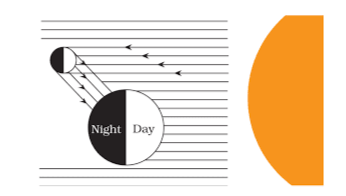
Ek month mein hum moon ki jitni shapes dekhte hai usko phases of moon kaha jata hai. India mein toh mostly festivals phases of moon ke according hi celebrate kiye jate hai. Eg- Diwali, new moon day par celebrate ki jati hai; Buddh poornima aur Guru nanak’s birthday full moon day par celebrate kiya jata hai. Aise aur bhi bahut saare festivals hai.
Moon ke 8 phases hote hai aur yeh sabhi phases 29 days se kuchh jyada time mein repeat hote hai jisko hum almost one month bolte hai.
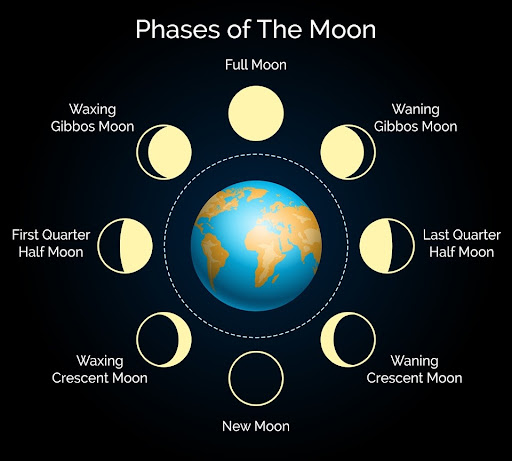
Jis din hamein moon poora dikhai deta hai uss din ko hum “Full moon day” kehte hai. Full moon day par sunlight poore moon par padti hai isliye hamein woh poora dikhai deta hai lekin iske baad moon apni position change karta hai aur sunlight receiving part decrease hota jata hai jiski wajah se day by day moon hamein thinner appear hota hai.
Full moon day ke baad thin hote hote 15th day par moon bilkul disappear ho jata hai, iss day ko hum “New moon day” kehte hai. New moon day se next day jab moon appear hota hai usko hum “crescent moon” kehte hai. Iske baad dheere dheere moon fir se increase karna start karta hai aur new moon day ke 15 days bad fir se full moon day aata hai aur yeh cycle aise hi chalta rehta hai.
The Moon’s Surface
Moon poetries aur stories mein bahut hi fascinating object lagta hai lekin actual mein moon ka surface bahut dusty aur barren hai. Waha par bahut saare craters bhi present hai aur waha par bahut saare steep aur high mountains bhi hai. Moon par na to water present hai aur na hi koi atmosphere present hai.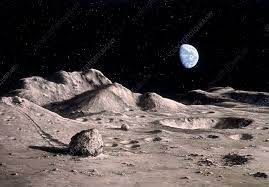
Atmosphere ke absence ki wajah se yaha koi bhi gases present nahi hai isliye yaha sound travel nahi kar pati aur hum kuchh bhi nahi sunn paate. Moon par sound travel nahi karti isliye astronauts waha par microphones ke through baat karte hai. Neil Armstrong moon par land karne wale first astronaut the. Armstrong ne 21 july, 1969 ko first time moon par land kiya tha.
The Stars
Stars aise celestial bodies hai jo hot gases se mil kar baney hai, inki apni khud ki light hoti hai. Sky mein bahut saare stars present hote hai lekin yeh sabhi same nahi hote. Yeh brightness, colour, size aur temperature mein vary karte hai. Stars ka size bahut big hota hai lekin earth se bahut jyada distance par hone ki wajah se yeh hamein point sized dikhai dete hai.
Sun is the biggest star of the solar system. Stars day time mein bhi sky mein present hote hai lekin sunlight ki presence ki wajah se yeh hamein day time mein visible nahi hote hai aur yeh hamein sirf night time mein visible hote hai. Stars ek place par fixed nahi hote, yeh east to west move karte hai aur earth apne axis par west to east move karti hai. Lekin pole star ek aisa star hai jo apni position par fix rehta hai, yeh earth ki axis ke direction mein hota hai aur move nahi karta.
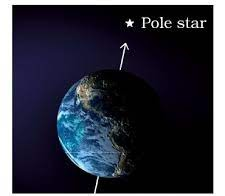
Light year
Constellations
Ek group of stars jo ek recognisable shape form karta hai usko constellation kehte hai.
Aise to constellations mein bahut saare stars hote hai lekin hamein sirf bright stars hi nazar aate hai. Constellations ancient people ka stars ko recognise karne ka way tha. The shapes of constellations resemble objects familiar to those people. 
Agar hamein constellation ki shape aur direction pata ho toh hum usko easily night sky mein locate kar sakte hai. Ab hum kuchh major constellations ke baare mein padhenge.
Ursa Major or Saptarishi


Ab hum janege ki hum ursa major ki help se pole star ko kaise locate kar sakte hai.
Orion or The Hunter
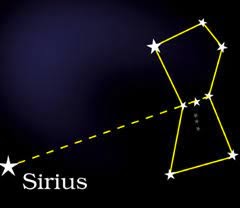
Cassiopeia
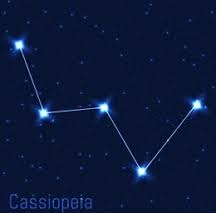
The Solar System
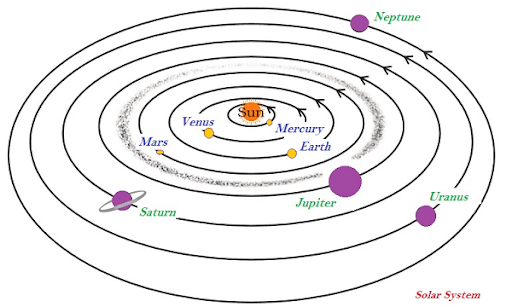
Ab hum sun aur other planets ke baare mein padhenge.
The Sun
Sun hamara sabse nearest star hai aur sabhi planets continuously iske around revolve karte hai. Sun heat aur light ka ek great source hai. Earth aur baki planets ki almost saari energy ka main source sun hi hai. Lekin kya aapne kabhi socha hai ki yeh planets sun ke around revolve karte-karte sun mein hi fall kyo nahi hote?Hum jante hai ki sun sabhi planets par gravitational force exert karta hai lekin woh sun mein fall nahi karte kyonki woh sun ke around ek fixed path par revolve karte hai aur yeh revolution hi unko sun mein fall hone se prevent karta hai.
The Planets
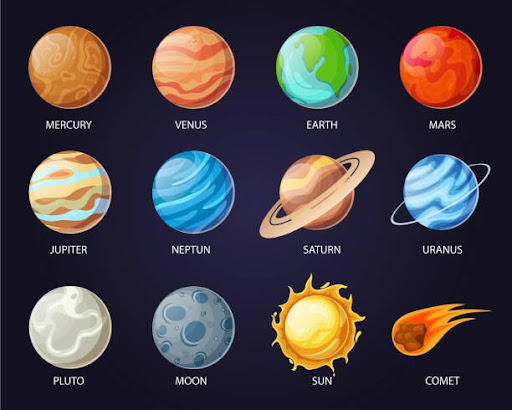
Ab hum sabhi planets ke baare mein detail mein padhenge.
Mercury (Budh)
Venus (Shukra)
The Earth (Prithvi)
Mars (Mangal)
Jupiter (Brihaspati)
Saturn (Shani)
Uranus and Neptune
Some Other Members of the Solar System
Sun aur planets ke alawa kuchh aur bodies bhi hai jo solar system ke members hai. Ab hum inke baare mein janege.
Asteroids
Asteroids are small rock-like objects that are found orbiting the sun.Mars aur jupiter ke orbit ke beech mein ek large gap hai, iss gap mein hum large telescope ki help se asteroids ko dekh sakte hai.
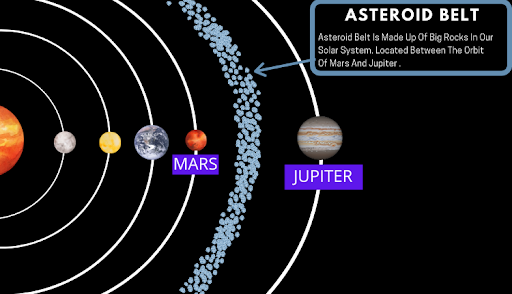
Comets
Comet bhi hamare solar system ka hi ek member hai, yeh sun ke around highly elliptical orbit mein revolve karte hai. Yeh apna ek revolution complete karne ke liye bahut time lete hai. Comet ka bright head hota hai aur long tail hoti hai aur jaise-jaise yeh sun ki taraf jata hai iska tail-size increase hota hai. Lekin comet ki tail ki direction hamesha sun se away hoti hai.Mostly comets ek particular time period ke baad dobara dikhai dete hai. Eg- Halley’s comet nearly every 76 years mein dikhai deta hai aur yeh last 1986 mein appear hua tha.

Comet ke baare mein kuchh superstitions bhi hai. Kuchh log comet ke appearance ko disaster ke indication ki tarah treat karte hai lekin aisa kuchh bhi nhi hota. Yeh ek natural phenomena hai.
Meteors and Meteorites
Sometimes jab moon appear nahi hota toh hamein light ki kuchh bright streaks dikhai deti hai, inko hum commonly shooting stars (toota tara) kehte hai lekin yeh stars nahi hote yeh meteors hote hai. Meteors occasionally earth ke atmosphere ke andar bahut fast speed se enter karte hai lekin atmosphere friction ki wajah se yeh heat up ho jate hai aur quickly evaporate ho jate hai. Yeh bahut hi less time ke liye appear hote hai.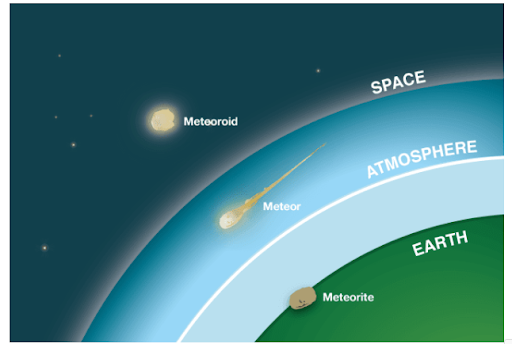
Kuchh meteors large bhi hote hai aur yeh completely evaporate hone se pehle earth par fall karte hai. Inko hum Meteorite kehte hai. Yeh scientists ko solar system ke nature of material ke baare mein janne mein help karta hai.
Jab earth comet ki tail ko cross karti hai toh bahut saare meteors dekhne ko milte hai, inko hum meteor showers kehte hai. Kuchh meteor showers ek regular interval par hote hai.
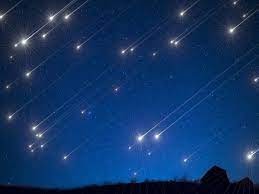
Artificial Satellites
Satellites ke baare mein hum upar padh chuke hai, ab hum janege ki natural satellites aur artificial satellites kaise different hai.Artificial satellites man-made hoti hai, yeh earth se hi launch ki jati hai aur yeh earth ki natural satellite se jyada earth ke close revolve karti hai.
India ne abhi tak bahut saari artificial satellites launch ki hai jaise- Aryabhata, INSAT, IRS, Kalpana-1, EDUSAT, etc. Aryabhata, India ki first artificial satellite thi.
Applications of artificial satellites- Inko weather forecast ke liye use kiya jata hai, radio aur TV signals transmit karne ke liye use kiya jata hai, telecommunication aur remote sensing (collecting information from a distance), etc. ke liye use kiya jata hai.

POINT 1
Celestial objects: The stars, the planets, the moon and many other objects in the sky are called celestial objects.
Astronomy: The study of celestial objects and associated phenomena is called astronomy.
Phases of moon: The various shapes of the bright part of the moon as seen during a month are called phases of the moon.
Light year: A light-year is defined as the measurement of length or the distance light travels in a vacuum in a year.
Constellation: The stars forming a group that has a recognisable shape is called a constellation.
Orbit: A planet has a definite path in which it revolves around the Sun. This path is called an orbit.
Solar system: The sun and the celestial bodies such as planets, comets, asteroids and meteors which revolve around the sun form the solar system.
Satellite: A satellite is a celestial body that revolves around a planet.
Star: Stars are the celestial bodies, which emit light of their own.
Planet: A planet is a large celestial body that revolves around the sun in fixed orbits.
Comets: Comets are celestial objects which revolve around the Sun in elliptical orbits with a very large period of revolution.
Meteors: Meteors are commonly called 'Shooting Stars' because they appear like bright streaks of light falling from the sky.
Meteorite: A meteorite is a small asteroid, ranging in size from several microns to 1 meter.
SUMMARY
1. The phases of the moon occur because we can see only that part of the moon which reflects the light of the Sun towards us.
2. Stars are celestial bodies that emit light of their own. Our sun is also a star.
3. It is convenient to express distances of stars in light years.
4. Stars appear to move from east to west.
5. The pole star appears to be stationary from the Earth, because it is situated close to the direction of the axis of rotation of the Earth.
6. Constellations are groups of stars that appear to form recognisable shapes.
7. The solar system consists of eight planets and a host of asteroids, comets and meteors.
8. A body revolving around another body is called a satellite.
9. Moon is the natural satellite of the Earth. Some planets also have natural satellites.
10. Venus is the brightest planet in the night sky.
11. Jupiter is the largest planet of the solar system.
12. The artificial satellites revolve around the Earth. They are much closer than the moon.
13. Artificial satellites are used for weather forecasting, long distance communication and remote sensing.